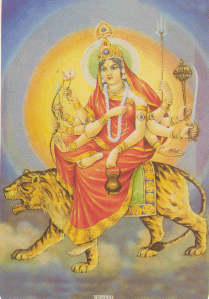Siddhidatri
On the ninth and last day of Chaita Navratri, Shakti is worshipped in the form of Siddhidatri (Siddhi=perfection, Datri=giver). In iconography, She is depicted with four arms and holds a lotus, conch, gada (mace), and chakra, and She sits on top of a lotus flower. She governs the planetary body Ketu, which is the southern lunar node.
This form of Shakti is worshiped by not only humans but also the other Gods. Her worship by Shiva is mentioned in Scripture, as related by Baba Rampuri:
When the Universal Mother was gripped with the idea of projecting Creation, She, first of all, created Lord Shiva who prayed to Her to endow him with perfections. For this purpose, the Universal Mother (Durgaa) produced Goddess Siddhidaatri from Her own person. As the behest of the Universal Mother, Goddess Siddidaatri bestowed eighteen kinds of rare perfections and powers and potentialities (Siddhis) on Lord Shiva. By virtue of these siddhis, Lord Shiva happened to develop a divine splendor.
Having acquired the siddhis from Goddess Siddhidaatri, Lord Shiva created Lord Vishnu who in turn created Lord Brahma who was entrusted with the task of the Creation whereas Lord Vishnu got the task of Protection and Lord Shiva that of Destruction.
Lord Brahma felt a great difficulty in his task of the Creation in the absence of man and woman. Thereupon he remembered Mother Siddhidaatri. When she appeared before him, Lord Brahma said to her, “Oh Great Mother! I cannot carry on with the task of the Creation in the absence of man and woman. You kindly solve this problem of mine through your supernatural attainments (siddhis).”
Having heard Lord Brahma, Mother Siddidaatri converted half the person of Lord Shiva into a woman. Thus Lord Shiva became half-male and half-female and came to be known as Ardhanaarishwara. Thus the problem of Lord Brahma was resolved and the task of the Creation went on smoothly.
Her mantra is:
Sidhha Gandharvay khshadher Surair Marair Api
Sevya Mana Sada Bhooyat Siddhida Siddhidayini
Which in English means:
Goddess Siddhidatri who is worshipped by Siddha, Gandharva, Yaksh, Gods, Demons etc., holds Conch, Chakra, Gada and Lotus in her hands, giver of all siddhis and victory all over, be propitious to me.
For purposes of pronunciation, I have included a link to the spoken mantra (The mantra itself lasts for the first minute of this video, after which a speaker gives a lecture in Hindi).
Resources:
http://experiencehinduism.com/festivals/navratri-ninth-day-nine-form-durga-siddhidatri
http://www.drikpanchang.com/hindu-goddesses/parvati/durga/navdurga-siddhidatri.html
http://www.astrosage.com/festival/navratri/devi-siddhidatri.asp
http://hinduism.about.com/od/godsgoddesses/ss/navadurga_10.htm
















